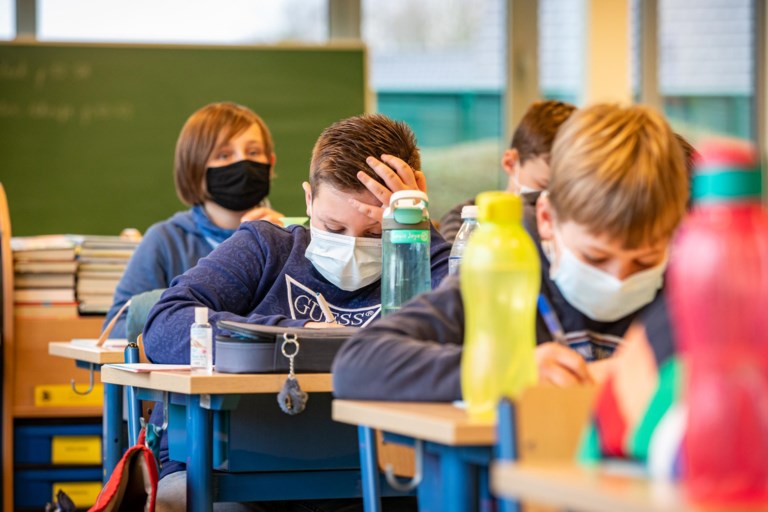On Monday evening, Flemish Education Minister Ben Weyts and representatives of the education sector agreed on a coronavirus barometer for schools, which is different from the barometer recently introduced for the general population.
While the barometer for the rest of society is limited to three colours (yellow, orange and red), the one for the education sector works with four colour codes, adding a 'green' phase. Yet as is the case with the societal barometer, the current situation in schools corresponds to code red.
"Each colour is linked to a basic package of measures concerning, for example, ventilation and distance. These measures are the main variables when switching colour codes, but are not set in stone," a press release from Weyts' cabinet stated.
Green for a return to normal
Depending on the situation or changing scientific insights, the guidelines in the barometer can be adjusted or supplemented by additional measures.
The added green colour denotes a return to near normality although schools will retain some measures introduced during the pandemic, such as a focus on good ventilation.
"With this extra colour code, we want to sketch an optimistic perspective, but also convey the message that we will not simply go back to the old normal," Weyts said. "In the new normal, we remember the lessons we learned during the coronavirus crisis."
Related News
- Denmark, UK and Ireland end almost all coronavirus measures
- Relaxed quarantine rules for schools 'will not solve problem,' says Van Gucht
- Coronavirus school closures and quarantines lead to an increase in temporary unemployment
The education sector already had a draft barometer ready in 2020 but decided it was so detailed that it would need to be adjusted too often. To make the coronavirus policy clearer and more practical, the initial design has been simplified.
Colour codes are decided after consultation with education partners and are based on the pandemic situation in the hospitals and the decisions of the Consultative Committee, among other things.
The aim is to extend the logic used in society at large into the education sector, linking a package of measures to each colour. However, a number of basic measures remain in force in nearly every phase:
- ventilation based on CO2 measurements in classrooms, recess halls and the teacher's room,
- face masks according to the rules of the society (currently, for everyone starting from 6 years old),
- those who are sick or infected stay at home,
- basic hand hygiene and coughing/sneezing in your elbow,
- keeping a social distance where possible and organising activities outdoors as much as possible.
Code red
In addition to the above set of basic measures, these additional measures are also in force in code red:
- extracurricular activities follow the rules of society,
- meetings at the school gate should be avoided, and the importance of distance should be stressed,
- staff members who can telework are subject to the measures of the wider society,
- meetings can only be held digitally,
- non-essential third parties are not allowed at school,
- class groups should not be mixed,
- pupils have a fixed seat in the classroom,
- trips lasting several days and staying overnight are only possible according to the rules of the society (youth and sports camps),
- parent-teacher conferences are digital, physical meetings are only possible in exceptional cases,
- in the context of enrolment, school visits are possible by reservation, outside of class hours and in limited groups.
Code orange
While the basic package of measures remains in force, a number of additional rules from 'code red' are lifted, leaving only the following ones in force:
- extracurricular activities follow the rules of society,
- meetings at the school gate should be avoided, and the importance of distance should be stressed,
- staff members who can telework are subject to the measures of the wider society,
- meetings are held digitally as much as possible
- non-essential third parties coming to school are not advised, the school determines who is essential
- class groups should not be mixed,
- pupils have a fixed seat in the classroom.
Code yellow
Here, too, the basic package of measures remains in force, but face masks are no longer mandatory, and a number of extra rules from 'code orange' are lifted again, leaving only:
- extracurricular activities follow the rules of society,
- meetings at the school gate should be avoided, and the importance of distance should be stressed,
- staff members who can telework are subject to the measures of the wider society.
Code green
With the exception of ventilation based on CO2 measurements in classrooms, recess halls and the teacher's room, and basic hygiene rules, no other measures are in force.
Like with any other disease, pupils who are sick or infected should stay home.
"This coronavirus barometer gives more guidance to the schools, but it is not a straitjacket," Weyts stressed.
More information about the coronavirus barometer that applies to the general population can be found here.

